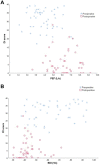Monitoring Adult Subglottic Stenosis With Spirometry and Dyspnea Index: A Novel Approach
- PMID: 34813409
- PMCID: PMC9442627
- DOI: 10.1177/01945998211060817
Monitoring Adult Subglottic Stenosis With Spirometry and Dyspnea Index: A Novel Approach
Abstract
Objective: The aim was to examine the correlations among the anatomic Cotton-Myer classification, pulmonary function tests (PFTs), and patient-perceived dyspnea or dysphonia in patients with subglottic stenosis and identify measurements accurately reflecting treatment effects.
Study design: Prospective cohort study.
Setting: Tertiary referral center.
Method: Fifty-two adults receiving endoscopic treatment for isolated subglottic stenosis were consecutively included. Correlations were calculated among the preoperative Cotton-Myer scale, PFTs, the Dyspnea Index (DI), and the Voice Handicap Index. Receiver operating characteristic curves were determined for PFT, DI, and Voice Handicap Index pre- and postoperative measurements.
Results: The Cotton-Myer classification correlated weakly with peak expiratory flow (r = -0.35, P = .012), expiratory disproportion index (r = 0.32, P = .022), peak inspiratory flow (r = -0.32, P = .022), and total peak flow (r = -0.36, P = .01). The DI showed an excellent area under the curve (0.99, P < .001), and among PFTs, the expiratory disproportion index demonstrated the best area under the curve (0.89, P < .001), followed by total peak flow (0.88, P < .001), peak expiratory flow (0.87, P < .001), and peak inspiratory flow (0.84, P < .001). Patients treated endoscopically with balloon dilatation showed a 53% decrease in expiratory disproportion index (95% CI, 41%-66%; P < .001) and a 37% improvement in peak expiratory flow (95% CI, 31%-43%; P < .001).
Conclusion: Expiratory disproportion index or peak expiratory flow combined with DI was a feasible measurement for the monitoring of adult subglottic stenosis. The percentage deterioration of peak expiratory flow and increase in expiratory disproportion index correlated significantly with a proportional percentage increase in DI.
Keywords: dyspnea index; expiratory disproportion index; functional assessment; peak expiratory flow; subglottic stenosis.
Conflict of interest statement
Figures


References
Publication types
MeSH terms
LinkOut - more resources
Full Text Sources

